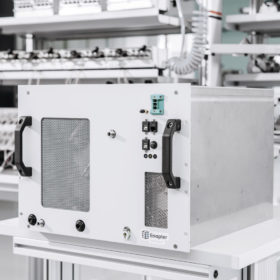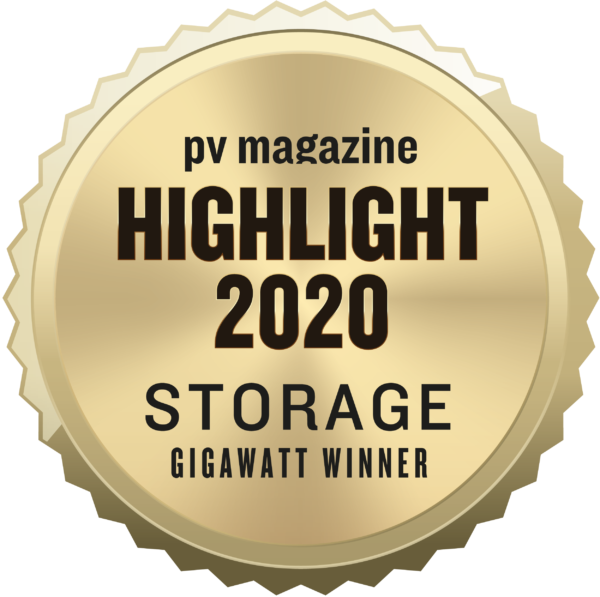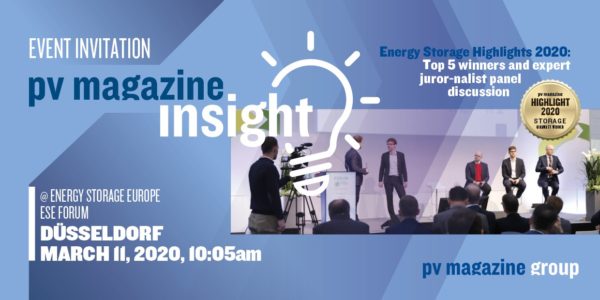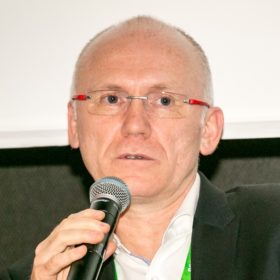
And so it is again. With the new decade, pv magazine brings forth yet another energy storage highlights. Approximately two weeks of work went into sifting through this year’s 22 highlights submissions, conducting research, and preparing them for the jury. Once again, this year’s work was crowned by the moderation of the jury meeting, in which six leading industry experts discussed the technologies and solutions. Differing from previous years, the jurors have selected the top five “Gigawatt” winners, followed by five “Megawatt” winners, and a series of “Finalists” which will be published in the coming weeks, leading up to Energy Storage Europe.
Built in partnership with Messe Düsseldorf and Energy Storage Europe, pv magazine’s annual Energy Storage Highlights 2020 special edition is hot off the press. Join us at the Energy Storage Europe trade fair and conference, taking place March 10-12 in Düsseldorf, Germany. Celebrate this year’s top five awardees at our Insight panel session with discussion among our Gigawatt winners and panel of expert jurors. 
Introducing our first Gigawatt Winner…
Enapter
Distributed hydrogen generation at a low cost
In recent years, it has been made clear at Energy Storage Europe that a wave of hydrogen developments is on the horizon. This year, market entries in the field have finally arrived. Small devices produced in high volumes without expensive precious metals are needed. Enapter wants to produce low-cost, distributed green hydrogen to revolutionize the market. The jury placed the company among one of the top 5 gigawatt winners.
A key question that arises for the sector is how decentralized hydrogen generation might be. Enapter, a proponent of a distributed approach, appealed to jurors with its offering of a small 2.4 kW electrolyzer. The company has a goal for the low costs it wants to achieve, and provides a concept to realize this goal, which seems to offer a unique selling proposition in the market.
The heart of the small electrolyzer, which is the size of a microwave oven, is a so-called anion exchange membrane (AEM), which distinguishes it from the PEM electrolyzers on the market that use proton exchange membranes. The advantage of Enapter technology is that no highly corrosive acids are used, explains Jan-Justus Schmidt, the company’s founder and managing director of Enapter. This means that expensive precious metals are not needed for the electrodes.
With a targeted service life of 30,000 hours, the company currently has achieved a price of €6.70 per kilogram of hydrogen, corresponding to €0.20 cents per kWh of thermal energy when the hydrogen is burned. However, these figures do not take into account the cost of the 54 kilowatt-hours of electricity that are currently still required to produce one kilogram of hydrogen.

Today’s costs are therefore in line with the cost of hydrogen produced with other electrolysis technologies, although the market spread is large. Additionally, Enapter’s process is likely still two to three times more expensive than hydrogen produced from fossil fuels via steam reforming.
But Enapter has clear ideas about how to continue to drive down costs. Recently, it increased the production volume of its factory in Pisa, Italy, eightfold and reduced costs by 20%. By further scaling up production to large quantities, the cost target of €1.50 per kilowatt-hour should be achieved “well before 2030,” according to the company. To deliver this, a production facility with a capacity of 100,000 units per year is scheduled to go online in Pisa in four to five years.
Schmidt draws parallels to the computer world to underscore the plausibility of the concept. Distributed personal computers have replaced mainframe computers to a great extent because, due to mass production, they are cheaper to manufacture than small numbers of mainframes. Similarly, the Enapter product is expected to reduce costs compared with the cost of central electrolyzers, which are not manufactured on an industrial scale.
There are many potential applications; the devices would be well suited to convert even small surplus quantities of electricity generated by domestic PV systems into hydrogen. A single device produces about 40 grams of hydrogen per hour. This amount is sufficient for one kilowatt of electricity when converted back, or for an approximate 10-kilometer drive with a fuel-cell vehicle. Other applications that Enapter describes are a backup system for longer-lasting power failures, seasonal energy storage in remote locations, or the operation of a company’s own industrial hydrogen filling station.
Ultimately, cost structures and markets will decide where distributed and centralized concepts are more competitive. Distributed concepts, apart from offering the advantages Enapter claims they do, might save grid costs. On the other hand, large volumes of hydrogen are needed in industry, which favors large-scale electrolyzers. Of course, in the end, one could also stack Enapter’s devices. About 416 electrolyzers produce the equivalent of 1 MW of electrical power.
Jury comments
Florian Mayr: “Green hydrogen will be one of the key ingredients to achieve maximum decarbonization, but costs still need to come down substantially. Enapter’s approach to reduce capex through low-cost materials and the mass-production of standardized and stackable small-scale electrolyzers seems promising.”
Mark Higgins: “Cost-effective, distributed green hydrogen is a unique concept; should the commercial model prove viable, Enapter will have developed a truly unique value proposition.”
Nina Munzke: “Good approach with a clear price target.”
Jurors
Lắp đặt điện mặt trời Khải Minh Tech
https://ift.tt/2X7bF6x
0906633505
info.khaiminhtech@gmail.com
80/39 Trần Quang Diệu, Phường 14, Quận 3
Lắp đặt điện mặt trời Khải Minh Tech
https://ift.tt/2ZH4TRU






Không có nhận xét nào:
Đăng nhận xét